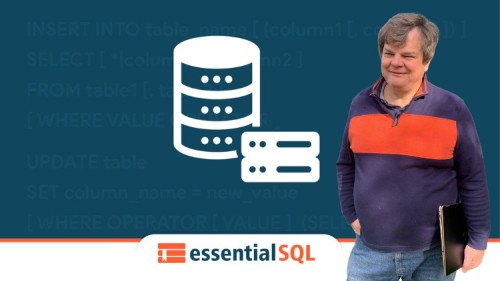
Subquery Magic: Write Awesome Sql, Master T-Sql Sub Queries
Last updated 6/2024
MP4 | Video: h264, 1280x720 | Audio: AAC, 44.1 KHz
Language: English | Size: 678.82 MB | Duration: 2h 9m
Subquery MySql, PostgreSQL, SQLite, Microsoft SQL Server | TSQL | Correlated subquery | Inner query | Nested query
Write subqueries to select data from multiple tables.
Create subqueries to return a single value or multiple values.
Use subqueries in the SELECT, FROM, WHERE, and HAVING clauses.
Understand and use correlated subqueries, which depend on values from the outer query.
Use subqueries to solve problems such as finding maximum or minimum values and records that don't have corresponding entries in other tables.
Understand the difference between IN, EXISTS, and ANY/ALL operators in subqueries.
How to use subqueries to create more complex queries and better understand the structure and relationships in a database.
Requirements
You should already be familiar with SELECT, GROUP BY, and ORDER BY clauses
If you can write a simple select statement, then you're ready for this course!
No special equipment needed, all exercises are done online.
Optional: Install a MySQL, PostgreSQL, or SQL Server learning lab on your own computer.
Description
In this course, you will learn the fundamentals of subqueries and how to use them effectively in your MySql, PostgreSQL, or MS SQL Server SQL statements. You will learn about different types of subqueries, including correlated and uncorrelated subqueries, and how to use them to solve complex problems. You will also learn about common pitfalls to avoid when working with subqueries, and how to optimize their performance in your queries.By the end of this course, you will have a solid understanding of how to use subqueries in your SQL statements, and be able to apply this knowledge to a wide range of real-world scenarios.In this Course you will Learn to:Know and understand subqueries.Identify subqueries in SQL.Use subqueries in your select statement to make your queries more robust and less reliant on hard coded values.Harness the power of derived tables to work around SQL limitations. Derived tables are also known as subqueries in the FROM clause.Use subqueries in the WHERE clause with EXISTS and INUse subqueries with SUM, MAX and other Aggregate functions in GROUP BY and HAVING.Write correlated subqueries so that your subquery is able work with the outer query to become more flexible and robust.Nothing is worse thanBeing excited to learn something new but not knowing where to start.Wasting time learning the wrong features.Being overwhelmed with options and not know which to use.Imagine Having...Knowledge - Knowing how to quickly use subqueries to take your SQL to the next level.Confidence - Feeling good that you're on the right track.Accomplishment - Having a sense of accomplishment that you've learned something most cannot.Fun - Actually having fun learning SQL subqueries!By the time you've completed this SQL course you'll have an appreciation of subqueries, overcome your fear, and able to write correlated queries to make your SQL more robust.
Overview
Section 1: Introduction
Lecture 1 Welcome to Subquery Magic
Lecture 2 What is a Subquery?
Section 2: Setting Up Your Learning Lab
Lecture 3 Should I use SQL Server, MySQL or PostgreSQL to Learn Subqueries?
Lecture 4 Using the Pizza DB in this Course
Lecture 5 Using the Pizza DB with SQL Server
Lecture 6 Using the Pizza DB with MySQL
Lecture 7 Using the Pizza DB with PostgreSQL
Section 3: Writing your First Subquery
Lecture 8 Place a subquery in the column list
Lecture 9 Incorporate Subqueries into Expressions
Section 4: Create Correlated Subqueries
Lecture 10 Demystify Correlated Subqueries
Lecture 11 Demystify Correlated Subqueries - Example
Lecture 12 Write a Correlated Subquery with Two Tables
Lecture 13 Do you have any questions?
Lecture 14 Correlated subqueries versus Inner Joins, which is better?
Section 5: Create Subqueries in the WHERE and HAVING Clauses
Lecture 15 Get Existential with Exists
Lecture 16 Are you in? Use the IN Condition to Test for Membership
Lecture 17 Subquery in the Having Clause
Lecture 18 Get fancy and write a correlated subquery in the HAVING clause
Lecture 19 Get fancy and write a correlated subquery in the HAVING clause - Part B
Section 6: Write Queries using Derived Tables
Lecture 20 What is a Derived Table?
Lecture 21 Joining Derived Tables
Section 7: Wrap-up
Lecture 22 Bonus Lecture
Beginner SQL query authors curious about subqueries.,If you're struck writing subqueries or baffled by correlated subqueries, then this course is for you!,Business analysts looking more ways to write queries,Recent college graduates looking to hone their SQL skills,Job applicants looking for that extra edge with their next interview!
Screenshots